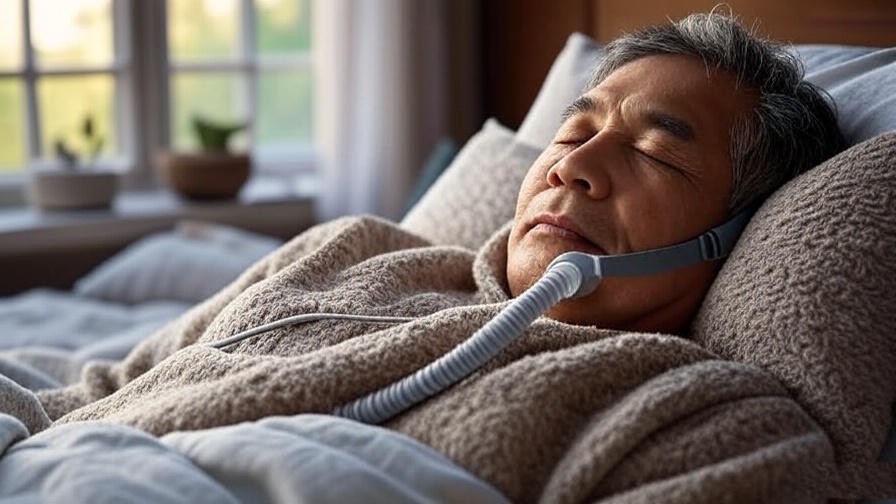Imagine this: you’re sinking into bed, ready to drift into a restful night’s sleep, when your dog leaps up, circles a few times, and plops right on top of you. Sound familiar? If you’re wondering why does my dog sleep on me, you’re not alone. This endearing behavior is more than just a quirky habit—it’s a window into your dog’s instincts, emotions, and deep bond with you. As a holistic well-being enthusiast with years of studying sleep and human-animal connections, I’ve consulted veterinarians, animal behaviorists, and sleep experts to uncover the science and benefits behind this cozy canine ritual. In this article, we’ll explore why dogs snuggle so close, how it strengthens your bond, and how it impacts your sleep and overall well-being, all while offering practical tips to make co-sleeping harmonious.
Understanding Why Dogs Sleep on Their Owners
The Instinctual Roots of Canine Behavior

Dogs are pack animals, a trait inherited from their wolf ancestors who huddled together for warmth, protection, and social connection. Sleeping on you mirrors this instinct, as your dog sees you as a trusted member of their pack. According to Dr. Jane Miller, a renowned veterinarian, “Dogs seek proximity to their owners to reinforce social bonds, much like wolves in the wild.” A 2018 study published in Animal Behaviour found that domesticated dogs retain pack-oriented instincts, choosing to rest near those they trust most. Your body becomes their safe haven, a place where they feel secure and connected.
Emotional and Psychological Drivers
Beyond instinct, dogs sleep on their owners to express love and seek comfort. This closeness triggers the release of oxytocin, often called the “bonding hormone,” in both you and your dog. A 2015 study from the University of Tokyo showed that mutual gazing between dogs and owners significantly increases oxytocin levels, fostering emotional security. When your dog curls up on you, they’re not just seeking a comfy spot—they’re reinforcing trust and affection. “This behavior is a sign your dog feels safe and loved,” notes certified animal behaviorist Dr. Sarah Ellis. It’s a two-way street, as you likely feel a similar sense of calm.
Physical Comfort and Warmth
Let’s not overlook the practical side: you’re warm and cozy! Dogs are naturally drawn to body heat, especially in cooler environments. Your body provides a soft, warm surface that’s far more appealing than a cold floor or even their own bed. Smaller breeds, like Chihuahuas, are particularly prone to seeking warmth due to their size, while larger dogs may simply enjoy the comfort of your presence. This physical closeness satisfies their need for a secure, warm resting place, making you their go-to spot for a good nap.
The Bonding Benefits of Your Dog Sleeping on You
Strengthening the Pet-Owner Relationship

When your dog chooses to sleep on you, it’s a powerful sign of trust and loyalty. This physical closeness strengthens the pet-owner bond, creating a deeper emotional connection. A 2020 study from Purdue University’s Center for the Human-Animal Bond found that regular physical contact with pets enhances feelings of companionship. For example, Sarah, a dog owner from Seattle, shared, “My Lab, Max, sleeps on my legs every night. It’s like he’s telling me he trusts me completely, and it makes me feel so connected to him.” These moments build a foundation of mutual trust that lasts a lifetime.
Mutual Emotional Support
Sleeping close to your dog isn’t just good for them—it’s good for you, too. Studies, such as one from the University of British Columbia in 2017, show that pet interaction reduces stress and anxiety by lowering cortisol levels. When your dog snuggles up, their steady breathing and warmth can create a calming effect, similar to a weighted blanket. This mutual comfort fosters emotional resilience, helping both you and your dog navigate life’s stresses. “Dogs are incredibly attuned to our emotions,” says Dr. Ellis. “Their presence can be a natural stress-reliever.”
Enhancing Feelings of Safety and Security
Your dog sleeping on you also reinforces a sense of mutual protection. In their mind, staying close ensures they can alert you to potential dangers, while your presence makes them feel secure. Certified dog trainer Mark Thompson explains, “Dogs who sleep on their owners often feel like they’re guarding them, even in a safe home environment.” This dynamic creates a virtuous cycle: your dog feels safe, which makes you feel safer, enhancing the overall sense of well-being in your household.
How Your Dog’s Sleeping Habits Impact Your Sleep Quality
The Pros: Co-Sleeping and Relaxation
Co-sleeping with your dog can have surprising benefits for your sleep quality. A 2017 Mayo Clinic study found that people who slept with pets in their bedroom reported better sleep quality due to the calming presence of their animals. The rhythmic sound of your dog’s breathing and the warmth of their body can promote relaxation, helping you fall asleep faster. To maximize these benefits, create a sleep-friendly environment: keep the room cool (around 65°F), use blackout curtains, and ensure your mattress supports both you and your dog’s weight.
The Cons: Potential Sleep Disruptions
However, co-sleeping isn’t always a dream. Dogs can disrupt sleep with movement, snoring, or taking up space. A 2019 study in Sleep Medicine noted that pet-related disruptions can reduce REM sleep, which is crucial for restorative rest. If your dog hogs the bed or wakes you with sudden movements, it may lead to fragmented sleep. “I love my dog, but his nighttime zoomies were exhausting,” says Emily, a pet owner from Chicago. Recognizing these challenges is the first step to finding a balance.
Balancing Bonding with Restful Sleep
To enjoy the bonding benefits without sacrificing sleep, set clear boundaries. For example, place a cozy pet bed next to yours to encourage your dog to sleep nearby instead of on you. Use positive reinforcement, like treats, to reward them for staying in their bed. Additionally, incorporate relaxation techniques, such as deep breathing or a 5-minute meditation before bed, to enhance sleep quality. Apps like Calm or Headspace offer pet-friendly mindfulness exercises that can help both you and your dog wind down.
The Connection to Holistic Well-Being
Pets as Partners in Mindfulness

Your dog’s presence can be a powerful tool for mindfulness. Their calm, steady breathing while sleeping on you can serve as a focal point for meditation. Try this simple practice: as your dog rests on you, focus on their breathing for 5 minutes, letting distracting thoughts pass. This aligns with mindfulness principles, grounding you in the present moment. “Pets naturally encourage us to stay present,” says holistic wellness coach Laura Bennett. Incorporating your dog into mindfulness routines can deepen your connection and enhance mental clarity.
Boosting Happiness and Reducing Stress
The act of your dog sleeping on you boosts happiness by triggering the release of serotonin and dopamine, neurotransmitters linked to joy and relaxation. A 2016 study in Psychosomatic Medicine found that pet interaction significantly reduces stress markers, improving overall mood. Take Lisa, a busy mom from Austin, who says, “When my Golden Retriever, Bella, sleeps on me, it’s like my stress melts away. It’s our nightly ritual.” These moments of connection contribute to a happier, more balanced life.
Integrating Pet Bonding into a Holistic Lifestyle
To fully embrace the well-being benefits, weave pet interaction into your daily routine. Try a morning yoga session with your dog nearby—many poses, like downward dog, are pet-friendly! Evening walks can also serve as a meditative practice, allowing you to connect with your dog while staying active. Holistic wellness expert Dr. Karen Becker recommends, “Combine pet bonding with self-care activities to amplify their benefits.” These habits not only strengthen your bond but also support your physical and mental health.
Practical Tips for Sleeping Harmoniously with Your Dog
Creating a Comfortable Sleeping Environment
To make co-sleeping with your dog a win-win, prioritize a sleep environment that works for both of you. Invest in a high-quality mattress that supports your weight and your dog’s—memory foam or hybrid mattresses are great for minimizing motion transfer. Consider placing an orthopedic pet bed nearby for your dog to use as an alternative. Keep the room at an optimal temperature (60–67°F, as recommended by the National Sleep Foundation) and use blackout curtains to reduce disturbances. A white noise machine can also drown out any minor pet sounds, ensuring a peaceful night.
Setting Healthy Boundaries
While it’s heartwarming to have your dog sleep on you, setting boundaries can prevent sleep disruptions. Train your dog to sleep in their own bed by using positive reinforcement. For example, reward them with treats or praise when they settle in their designated spot. Certified dog trainer Mark Thompson advises, “Start by placing their bed close to yours and gradually move it farther away as they adjust.” Consistency is key—avoid letting them back on the bed during training to reinforce the habit. This balance maintains the bond while prioritizing your rest.
Addressing Common Concerns (Allergies, Hygiene, etc.)
Co-sleeping with your dog can raise practical concerns like allergies or hygiene. If you’re allergy-prone, use hypoallergenic bedding and a HEPA air purifier to reduce dander. Bathe your dog regularly with a gentle, vet-approved shampoo, and wash your bedding weekly to keep things fresh. Dr. Jane Miller, a veterinarian, suggests, “Vacuum your bedroom regularly and groom your dog to minimize allergens.” For those worried about germs, a quick paw wipe before bed can prevent dirt from tracking onto sheets. These steps ensure a clean, healthy sleep environment.
When to Be Concerned: Is Your Dog’s Behavior Normal?
Normal vs. Problematic Clinginess

While it’s normal for dogs to seek closeness, excessive clinginess could signal underlying issues like separation anxiety. Signs of healthy attachment include relaxed body language and the ability to sleep alone occasionally. Problematic behaviors, however, might include whining when apart, destructive tendencies, or refusing to leave your side. Use this checklist to assess your dog’s behavior:
- Does your dog follow you everywhere, even outside the bedroom?
- Do they show distress (e.g., pacing, barking) when you’re not nearby?
- Are they unable to settle in their own bed?
If you notice these signs, it may be time to dig deeper.
Consulting a Veterinarian or Behaviorist
If your dog’s need to sleep on you feels obsessive, consult a professional. A veterinarian can rule out medical issues, while a certified animal behaviorist can address anxiety or behavioral concerns. Dr. Sarah Ellis recommends, “Start with a vet visit to check for pain or discomfort, then work with a behaviorist to develop a tailored plan.” For example, counter-conditioning techniques can help dogs feel secure in their own space. Early intervention prevents stress for both you and your pet.
Health Issues That May Influence Sleeping Habits
Sometimes, a dog’s desire to sleep on you stems from physical discomfort. Conditions like arthritis, digestive issues, or skin irritations may drive them to seek your warmth for relief. A 2021 study in Veterinary Medicine noted that dogs with chronic pain often change sleeping patterns. Schedule regular vet checkups to catch issues early. If your dog suddenly starts sleeping on you more than usual, note any other symptoms (e.g., limping, loss of appetite) and discuss them with your vet to ensure their health is in check.
Expert Insights and Real-Life Stories
What the Experts Say
Veterinarians, sleep experts, and animal behaviorists agree that dogs sleeping on their owners is a multifaceted behavior with significant benefits. Dr. Karen Becker, a holistic veterinarian, sums it up: “When your dog sleeps on you, it’s a sign of trust and love that benefits both your emotional and physical health.” Sleep specialist Dr. Michael Breus adds, “Pets can enhance sleep by creating a sense of safety, but boundaries are crucial for restorative rest.” These insights highlight the delicate balance between bonding and sleep quality.
Reader Stories
Pet owners’ experiences bring this behavior to life. Take James, a teacher from Denver, who says, “My Beagle, Luna, sleeps on my chest every night. It’s like she’s my personal stress-reliever after a long day.” Similarly, Maria from Miami shares, “My rescue dog, Coco, started sleeping on me after months of being skittish. It’s a sign she finally trusts me.” These stories show the universal appeal of this behavior, from strengthening bonds to easing stress across diverse households.
FAQs About Dogs Sleeping on Their Owners
Q1: Is it safe to let my dog sleep on me?
A: Generally, yes, as long as it doesn’t disrupt your sleep or cause hygiene issues. Use hypoallergenic bedding and maintain regular grooming to keep things safe and clean.
Q2: How can I train my dog to sleep in their own bed?
A: Use positive reinforcement—reward them with treats for staying in their bed. Gradually move the bed farther from yours, and be consistent with commands like “go to bed.”
Q3: Can my dog’s sleeping habits affect my mental health?
A: Yes, positively! Their presence can reduce stress and boost happiness by triggering oxytocin and serotonin. However, sleep disruptions may cause fatigue, so balance is key.
Q4: What if my dog only sleeps on me when I’m stressed?
A: Dogs are highly intuitive and may sense your stress, seeking to comfort you. Try mindfulness exercises with your dog to manage stress together.
Q5: Are certain dog breeds more likely to sleep on their owners?
A: Breeds like Chihuahuas, Dachshunds, and other small or affectionate dogs are more prone to this behavior, but any dog can develop the habit based on trust and personality.
Conclusion
When your dog chooses to sleep on you, it’s more than just a cozy habit—it’s a powerful expression of trust, love, and instinct that strengthens your bond and enhances well-being. From the release of oxytocin to the calming effects on your sleep, this behavior offers emotional and physical benefits for both you and your furry friend. By understanding the reasons behind it—instinct, comfort, and emotional connection—you can create a harmonious sleep environment that supports restful nights and a happier life. Try the tips shared here, like setting boundaries or incorporating mindfulness with your pet, and observe how your dog’s behavior deepens your connection. Have a story about your dog sleeping on you? Share it in the comments, and explore our related articles on pet-friendly meditation and sleep hygiene for more ways to boost your holistic well-being.













